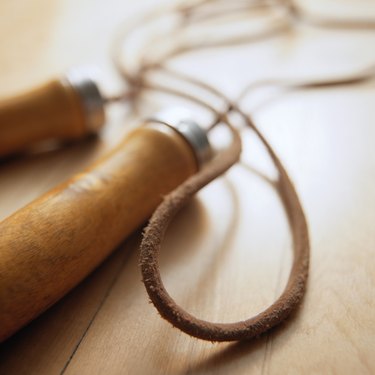
Jumping rope is part of training programs for Olympic wrestlers, boxers and other athletes. Trimming off pounds is just one of the benefits of jumping rope. The USDA emphasizes the positive effect jumping rope has on building bone mass, and the American Heart Association promotes jumping rope for cardiovascular fitness. Best of all, you can jump rope as part of a workout regimen to lose weight.
History
Video of the Day
Jumping plays a big part in how children play. From ancient times to the early 1900s, only men competed in speed and endurance jump rope contests. Women were not believed to have the physical ability to jump rope. Today, males and females of all ages jump rope to build coordination as well as burn calories.
Video of the Day
Weight Loss
The basics of any weight loss plan should include diet and exercise. To lose weight you need to expend more calories than you consume. Calories are a measure of energy, so calories burned by exercise depend on an individual's weight as well as activity intensity.
Calories and Weight
The American Heart Association has a chart showing that jumping rope burns 500 calories per hour for a 100-pound person, while a 200-pound individual would burn 1,000 calories per hour. Every time you jump, you are lifting your body weight off the ground. As such, the 200-pound person is lifting twice as much weight.
Calories and Intensity
The American Heart Association chart shows how intensity varies the number of calories burned. A 100-pound individual running at 5 mph burns 440 calories in an hour. Upping the pace to 10 mph increases the calories used in an hour to 850. Twirling the rope faster helps you burn more calories during a workout. However, your ability to keep up the pace depends on your fitness level. A 100-pound person may not be as fit as a 200-pound athlete.
Easy Calorie-Burning Variations
Fitness magazine recommends starting by jumping with both feet 2 to 6 inches off the ground as the rope turns. A rhythm will develop. Once you are comfortable doing single jumps, do double jumps. Increase the height of your jump and the speed of the rope so it passes under your feet twice with each jump. Try alternating your feet by picking up the pace until you're essentially running in place in rhythm with the jump rope.
Burn More Calories
More calories are burned when the speed or height of jumping rope is increased. Raising the knees higher while running in place requires more effort than minimally raising the feet to skip. Jumping on one foot improves balance and requires more abdominal muscle effort than jumping on two feet. Fitness magazine suggests incorporating figure of eight arm-cross movements to use more arm muscles to jump rope.
- The Jump Rope Institute: Jump Rope for Life
- American Alliance for Health, Physical Education, Recreation and Dance: Jump Rope for Heart
- American Heart Association: Physical Activity Calorie Use Chart
- U. S. Department of Agriculture: Best Bones Forever: Jumping Rope
- Fitness Magazine: 10-Minute Workout: Jump Rope to Skip Yourself Slim